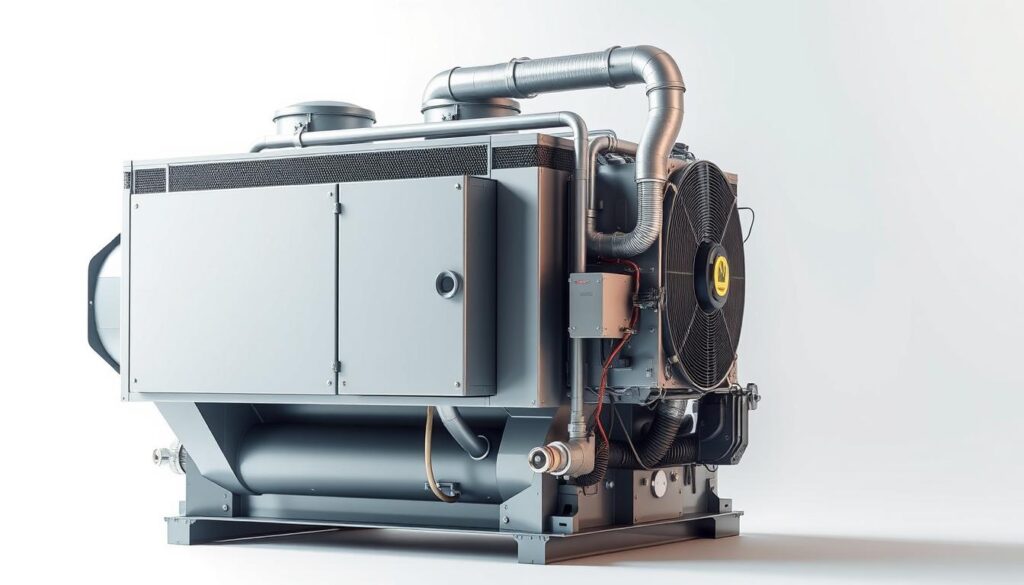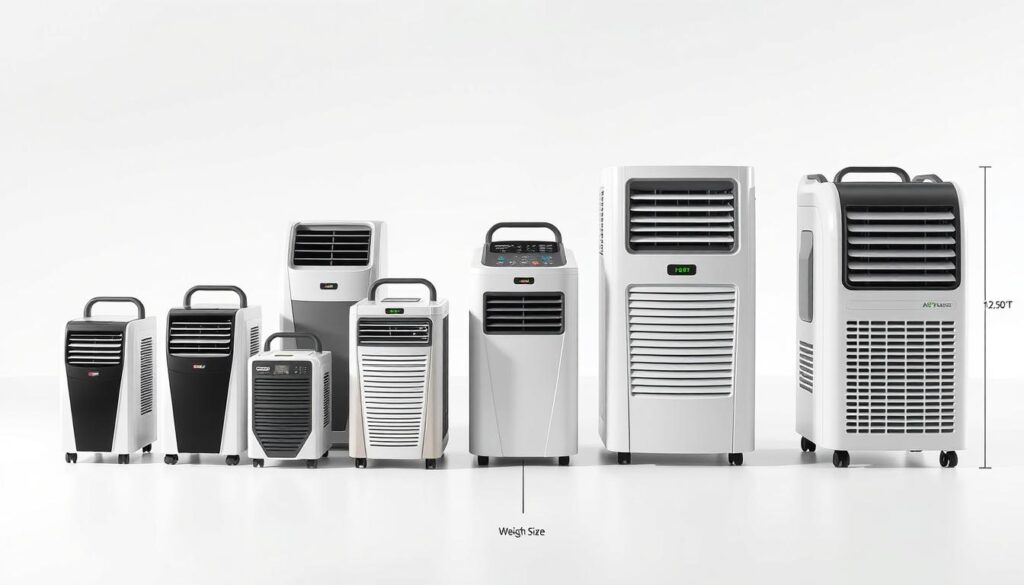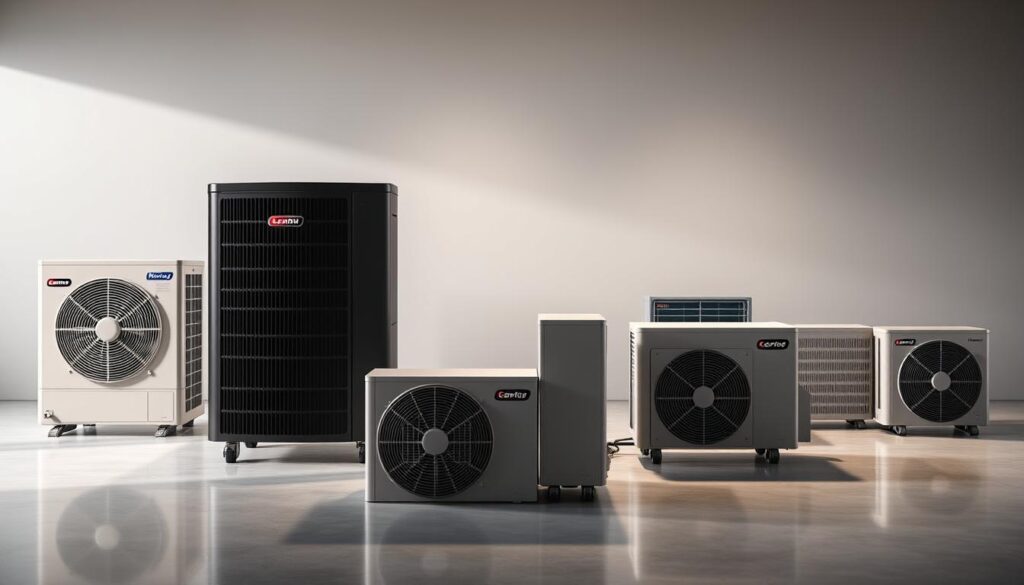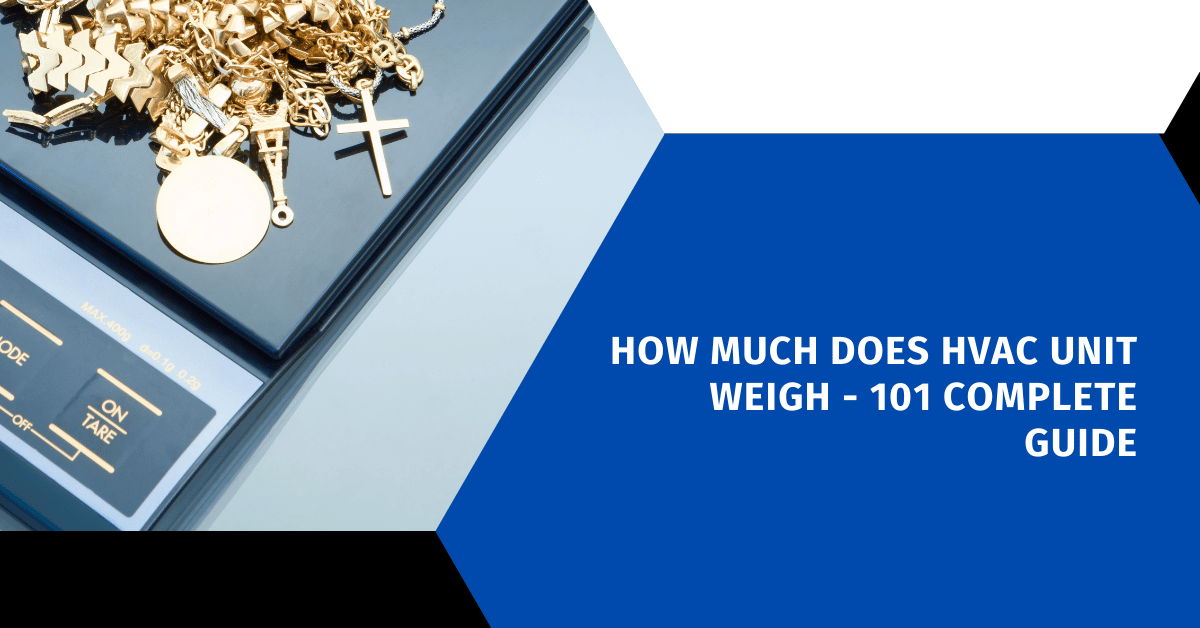Affiliate Disclosure
HVAC Guide Guys is a participant in the Amazon Services LLC Associates Program, an affiliate advertising program designed to provide a means for sites to earn advertising fees by advertising and linking to Amazon.
How Much Does HVAC Unit Weigh? Ever thought about why the weight of an HVAC unit is so important? Knowing how much an HVAC unit weighs is key. It affects how well your heating and cooling system works and how easy it is to install.

Most homeowners are surprised to find out that a typical air conditioner’s outside unit weighs between 150 to 210 pounds. This weight is not just random. It’s vital for the system’s support and how hard it is to install.
Your HVAC system does more than just cool or heat your home. Its weight affects your comfort and how efficient it is. It’s important to know about the weight before you install or replace it.
Key Takeaways
- HVAC unit weight varies significantly between residential and commercial systems
- Weight impacts installation, structural requirements, and system performance
- Different HVAC types have unique weight specifications
- Building codes often dictate weight-related installation requirements
- Professional assessment is key for proper HVAC unit placement
Table of Contents
Understanding HVAC Unit Weight Basics
Exploring HVAC systems means knowing their weight is key. The weight of your HVAC equipment affects its efficiency and the structure it needs. This is important for both heating and cooling.
HVAC systems have many parts that add up to their total weight. Knowing these parts helps you make smart choices about installation and upkeep.
Defining HVAC System Components
An HVAC system has several main parts that affect its weight:
- Outdoor condenser unit
- Indoor air handler
- Ductwork
- Refrigerant lines
- Electrical connections
Why Weight Matters in HVAC Installation
The weight of an HVAC system is very important. It ensures:
- The structure can hold the system
- The system works well
- It’s installed safely
- It meets building codes
Common Weight-Related Terminology
In HVAC, tonnage is often confused. It’s not about weight, but how much cooling your system can do. One ton means it can cool 12,000 British Thermal Units (BTUs) per hour.
“Understanding HVAC equipment weight is not just about numbers, but about ensuring optimal system performance and safety.” – HVAC Professional
Professional installers think about the weight of HVAC systems. They make sure it’s supported right, avoid damage, and keep your system working well for a long time.
Residential HVAC Unit Weight Range
When you’re looking at a residential HVAC system, knowing the weight of air conditioning units is key. A typical HVAC unit can weigh anywhere from 150 to 210 pounds when shipped. This weight varies based on several important factors.
The weight of your air conditioning unit depends on several elements. These include:
- Cooling capacity
- Energy efficiency ratings
- Manufacturer design
- Material composition
- Technological features
Different HVAC systems have their own weight characteristics. Central air conditioners, heat pumps, and furnaces each have unique weights. These weights affect your home’s cooling and heating setup.
Today’s HVAC technologies are getting lighter and more compact. Manufacturers use new materials to make units lighter without losing performance. This makes installation easier and might reduce the need for extra support.
Pro tip: Always consult with a professional HVAC technician to understand the specific weight requirements for your home’s unique installation needs.
Remember, weight is more than just a number. It’s vital for proper installation, keeping your home safe, and ensuring your cooling system works well for years.
Explore Our HVAC Shop
Looking for top-rated HVAC tools, parts, and accessories? Visit our shop and find the perfect solution for your needs.
Visit the ShopCommercial HVAC System Weights
Commercial heating and cooling systems are key for business spaces. Their weight changes a lot based on size, capacity, and use.
Knowing the weight of commercial HVAC units is vital for architects, engineers, and facility managers. Each system needs a careful look at how much weight it can handle and how to install it.
Light Commercial Units
Light commercial HVAC systems are for smaller areas like:
- Small retail stores
- Professional offices
- Small restaurants
- Medical clinics
These units weigh between 300-1,500 pounds. They’re made for moderate cooling and heating. Their design makes them easier to install in tight spaces.
Heavy-Duty Commercial Systems
Heavy-duty commercial systems can weigh from 1,500 to 5,000 pounds. They’re for:
- Large office complexes
- Industrial facilities
- Warehouses
- Shopping centers
Their weight shows their strong performance and detailed engineering.
Rooftop Unit Weight Specifications
Rooftop HVAC units have special weight needs. They need careful building analysis to keep structures safe. Rooftop units usually weigh 800-3,000 pounds, based on their size and design.
Always talk to structural engineers before installing commercial HVAC. They help check if the building can handle the system’s weight and ensure it’s installed right.
How Much Does HVAC Unit Weigh by Type
It’s important to know the weight of different HVAC units. This is key for proper installation and choosing the right system. The weight of an HVAC unit changes based on its design and cooling power. Knowing this helps with planning for installation, moving, and support needs.
Now, let’s look at the typical weight ranges for different HVAC systems:
- Split Systems
- Indoor Air Handler: 50-150 pounds
- Outdoor Condenser Unit: 100-250 pounds
- Total system weight: 150-400 pounds
- Packaged Units
- Residential units: 300-800 pounds
- Commercial units: 800-2,500 pounds
- Ductless Mini-Split Systems
- Indoor Unit: 20-50 pounds
- Outdoor Compressor: 50-150 pounds
- Geothermal Heat Pumps
- Indoor Unit: 100-250 pounds
- Ground Loop Components: 500-1,500 pounds
The weight of an HVAC unit depends on several things. These include its cooling power, energy efficiency, and how complex it is. When figuring out the weight of an HVAC unit, think about the model, brand, and special features that add to its mass.
Pro Tip: Always consult with a professional HVAC technician to get precise weight measurements for your specific system.
Explore Our HVAC Shop
Looking for top-rated HVAC tools, parts, and accessories? Visit our shop and find the perfect solution for your needs.
Visit the ShopWeight Factors Affecting HVAC Installation
Understanding the weight factors for HVAC systems is key to a successful installation. The weight of the equipment affects how complex and safe the installation will be.
Many factors influence the weight of an HVAC system. These include structural support and following building codes. Your specific situation will require careful thought.
Structural Support Requirements
Ensuring proper structural support is vital for managing the weight of HVAC equipment. Important factors include:
- Building’s load-bearing capacity
- Mounting surface strength
- Potential reinforcement needs
- Weight distribution mechanisms
Building Code Considerations
Local building codes have specific rules for HVAC system weight installations. These rules help keep structures safe and ensure equipment is placed correctly.
| Installation Location | Weight Limitations | Typical Support Requirements |
|---|---|---|
| Rooftop | 500-2000 lbs | Specialized mounting frames |
| Ground Level | 300-1500 lbs | Concrete pad foundation |
| Indoor Closet | 200-800 lbs | Reinforced wall mounting |
Installation Location Impact
The location of your HVAC installation greatly affects how you manage weight. Rooftop installations need special structural considerations compared to ground or indoor setups.
Getting a professional to assess your space is important. They can help find the best installation method while keeping safety and performance in mind.
Portable and Window AC Unit Weights

Choosing the right air conditioning unit means knowing the portable ac unit weight. This is key for your comfort and the installation process. Portable and window units are great for homes and offices with limited space.
The weight of air conditioning units varies a lot. Portable AC units usually weigh between 50 to 90 pounds. This makes them easy for one person to install. Window units are a bit lighter, weighing 40 to 70 pounds.
- Compact portable AC units: 50-60 pounds
- Mid-size portable AC units: 60-80 pounds
- Large portable AC units: 80-90 pounds
- Standard window AC units: 40-70 pounds
Choosing the right portable ac unit weight depends on a few things. Think about the room size, electrical outlets, and how easy it is to move the unit. Small units are good for apartments or single rooms. Larger units are better for bigger spaces or offices.
When picking an air conditioning unit, consider a few things:
- Mobility requirements
- Installation surface strength
- Cooling capacity needed
- Energy efficiency ratings
Pro tip: Always check the manufacturer’s specs for the exact portable ac unit weight before buying. This ensures it fits your space right.
Explore Our HVAC Shop
Looking for top-rated HVAC tools, parts, and accessories? Visit our shop and find the perfect solution for your needs.
Visit the ShopHVAC Equipment Weight and Building Requirements
It’s key to understand how HVAC equipment weight affects your building’s structure. The weight of your HVAC system is vital to your building’s safety. So, making accurate calculations is a must.
When setting up your HVAC, you need to think about a few important things. These factors help make sure your HVAC fits well with your building’s structure.
Load-Bearing Calculations
Load-bearing calculations are essential for your building’s safety. They involve:
- Measuring total hvac system weight
- Assessing structural capacity of support surfaces
- Determining weight distribution requirements
Roof Structure Considerations
Installing HVAC on your roof needs special care. Your roof must handle the weight of the HVAC without losing its strength.
| Roof Type | Weight Capacity | Reinforcement Needs |
|---|---|---|
| Flat Roof | 50-75 lbs/sq ft | Moderate |
| Pitched Roof | 40-60 lbs/sq ft | High |
| Metal Roof | 30-50 lbs/sq ft | Low |
Foundation Requirements
For HVAC units on the ground, a strong foundation is needed. It’s important to level and distribute the weight right. This prevents damage and keeps your system running well.
Getting a pro to check your building’s strength is smart. It helps avoid damage and ensures your HVAC is installed safely and efficiently.
Weight Considerations for Different HVAC Brands
When picking an HVAC unit, knowing the weight differences between brands is key. The weight of the HVAC unit affects installation, performance, and efficiency.

Top HVAC makers have different ways to handle air conditioning unit weight. They balance performance and installation needs in unique ways. Important factors include:
- Material composition of the unit
- Technological innovations
- Performance efficiency
- Installation flexibility
Brands like Carrier, Trane, and Lennox have various weight ranges for their systems. Lighter units are easier to install. Heavier ones might last longer and work better.
Pro tip: Always check your system’s current tonnage by reviewing the owner’s manual or examining the information plate on the outdoor unit.
When looking at hvac unit weight, think about these important points:
- Structural support needs
- Building code rules
- Specific installation location issues
Some makers have created lightweight materials. These materials cut down on air conditioning unit weight without losing performance. These tech steps can greatly change your HVAC system’s efficiency and how easy it is to install.
Explore Our HVAC Shop
Looking for top-rated HVAC tools, parts, and accessories? Visit our shop and find the perfect solution for your needs.
Visit the ShopTransportation and Installation Weight Guidelines
When moving and installing HVAC equipment, planning is key. The weight of your heating and cooling system is very important. Experts use special methods to handle different weights safely and efficiently.
Before moving your HVAC, think about a few important things:
- Weight-specific moving equipment
- Number of personnel required
- Vehicle capacity and load restrictions
- Safety protocols for heavy equipment
Each HVAC system has its own weight needs. Small units might need just two people, while big ones might need cranes.
| HVAC System Type | Typical Weight Range | Recommended Transportation Method |
|---|---|---|
| Residential Split System | 100-300 lbs | Two-person team, hand trucks |
| Commercial Rooftop Unit | 500-2000 lbs | Crane, specialized flatbed truck |
| Industrial HVAC System | 2000-5000 lbs | Heavy-duty crane, multiple personnel |
Your team must check the building’s support and codes before moving. Proper preparation prevents damage and ensures safe installation.
Safety first: Always consult professional HVAC technicians when dealing with heavy equipment transportation and installation.
Conclusion
Learning about the weight of an HVAC unit is key for homeowners and pros. Knowing the weight affects installation and how well the system works. It’s important for keeping your home safe and your system running right.
Choosing an HVAC system means more than just picking a size. The weight of the unit is tied to its design, your home’s needs, and how it’s installed. Experts use special calculations to find the best system for your home.
New HVAC systems are getting smaller and using less energy. This means they might weigh less but work just as well. Keeping up with these changes helps you make better choices for your home’s heating and cooling.
For the best advice on HVAC unit weight, talk to a certified HVAC pro. They can give you advice that fits your home’s needs and how you like to feel inside.

